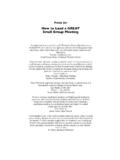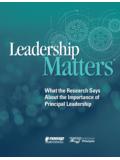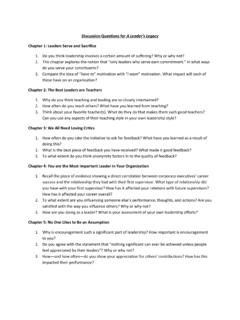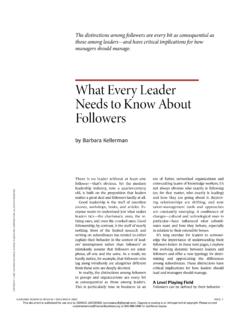Transcription of Why Great Leaders - pearsoncmg.com
1 Why Great Leaders Don t Take Yes for an AnswerManaging for Conflict and Consensus Michael A. Roberto Vice President, Publisher: Tim Moore Associate Publisher and Director of Marketing: Amy Neidlinger Executive Editor: Jeanne Levine Editorial Assistant: Pamela Boland Operations Specialist: Jodi Kemper Marketing Manager: Megan Graue Cover Designer: Chuti Prasertsith Managing Editor: Kristy Hart Senior Project Editor: Jovana San Nicolas-Shirley Copy Editor: Kitty Wilson Proofreader: Kathy Ruiz Indexer: Ken Johnson Compositor: Nonie Ratcliff Manufacturing Buyer: Dan Uhrig 2013 by Pearson Education, Inc. Publishing as FT Press Upper Saddle River, New Jersey 07458 FT Press offers excellent discounts on this book when ordered in quantity for bulk purchases or special sales. For more information, please contact Corporate and Government Sales, 1-800-382-3419.
2 For sales outside the , please contact International Sales at . Company and product names mentioned herein are the trademarks or registered trademarks of their respective owners. All rights reserved. No part of this book may be reproduced, in any form or by any means, without permission in writing from the publisher. Printed in the United States of America First Printing May 2013 ISBN-10: 0-13-309511-8 ISBN-13: 978-0-13-309511-1 Pearson Education LTD. Pearson Education Australia PTY, Limited. Pearson Education Singapore, Pte. Ltd. Pearson Education Asia, Ltd. Pearson Education Canada, Ltd. Pearson Educaci n de Mexico, de Pearson Education Japan Pearson Education Malaysia, Pte. Ltd. The Library of Congress cataloging-in-publication data is on file. To Luke, Celia, Grace, and Kristin Contents Preface.
3 XiiChapter 1 The Leadership Challenge .. 1 Conflict and Consensus .. 6 Decision-Making Myths .. 11 Managing Reality .. 17 The Absence of Dissent .. 18 Tragedy on Everest .. 19 The Perils of Conflict and Dissent .. 23 Why Is This So Difficult? .. 25A Deeper Explanation .. 29 Endnotes .. 30 Chapter 2 Deciding How to Decide .. 39 Managerial Levers .. 45 The Power to Learn .. 66 The Prepared Mind .. 68 Endnotes .. 68 Chapter 3 An Absence of Candor .. 75 Columbia s Final Mission .. 80 Hard Versus Soft 84 Leadership Matters .. 100 Endnotes .. 102 Chapter 4 Stimulating the Clash of Ideas .. 109 Caufield s Story .. 110 Pulling All the Right Levers .. 113 The Leader s Toolkit .. 115 Watch Out Situations .. 128 Practice Makes Perfect .. 135 Endnotes .. 138 CONTENTS vChapter 5 Keeping Conflict Constructive.
4 143 Diagnosing the Debate .. 144 Affective Conflict .. 147 Curbing Affective Conflict .. 149 Building a Capability .. 172 Freedom and Control .. 173 Endnotes .. 174 Chapter 6 A Better Devil s Advocate .. 179 The Devil s Advocate in Business .. 180 Inspiring Divergent Thinking .. 184 The Broken Record .. 198 Endnotes .. 200 Chapter 7 The Dynamics of Indecision .. 203A Culture of Indecision .. 205 The Origins of Indecisive Cultures .. 225 Endnotes .. 228 Chapter 8 Fair and Legitimate Process .. 233 Fair Process .. 235 Legitimate Process .. 249 Giving People Voice .. 257 The Misalignment Problem .. 258 Communicating Intent .. 260 Teaching Good Process .. 261 What About Conflict? .. 263 Endnotes .. 265 Chapter 9 Reaching Closure .. 271 Divergence and Convergence .. 274 The Psychology of Small Wins.
5 278 The 1983 Social Security Crisis .. 281 Types of Intermediate 282 Shifting into Decision Mode .. 290 Sustaining Closure .. 292 The Importance of Trust .. 293 Endnotes .. 297vi WHY Great Leaders DON T TAKE YES FOR AN ANSWERC hapter 10 Leading with Restraint .. 301 What Type of Leaders ?.. 303 The Myth of the Lone Warrior .. 304 Two Forms of Taking Charge .. 306 Leading with Restraint .. 309 Questions, Not Answers .. 311 Endnotes .. 313 Index .. 317 Acknowledgments This book could not have been written without the cooperation of those individuals who provided me remarkable access to their organizations, participated in interviews, completed surveys, and per-mitted me to observe them at work. Hundreds of insightful practi-tioners spent countless hours with me, patiently and conscientiously answering each of my questions.
6 They provided me a rich picture of the reality of organizational decision making complete with all its challenges and pitfalls. I appreciate their candor and openness. These skilled and experienced practitioners taught me a Great deal. My students deserve a special acknowledgment as well. As they discussed many of the cases in this book, they offered distinctive insights based on their work and life experiences. They pushed my thinking and forced me to sharpen my ideas. I am grateful for the opportunity to have worked with so many talented students at Bry-ant University, Harvard Business School, and New York University s Stern School of Business. These individuals remind me each and every day that a teacher cannot truly teach unless he strives to learn from, and with, his students.
7 I owe a tremendous debt to my colleagues with whom I have col-laborated over the past few years on numerous articles and case stud-ies. Many ideas in this book emerged from my work with talented scholars such as David Garvin, Amy Edmondson, Michael Watkins, Richard Bohmer, Lynne Levesque, Anita Tucker, Jan Rivkin, Sukki Yoon, and Brian Waddell. I have tried to give them proper credit throughout this book, as evidenced by the numerous citations in which their names appear. I want to especially thank David Garvin for serving as a mentor to me since my first days as a doctoral stu-dent at Harvard. He is a talented teacher and scholar with a deep understanding of management practice. Our collaborative endeavors have been a constant source of knowledge and insight for me.
8 Amy viii WHY Great Leaders DON T TAKE YES FOR AN ANSWERE dmondson also has had a unique impact. She often points out how much she has learned from me. In reality, however, it is I who has done the lion s share of the learning in our work together. Several other academic colleagues have been extremely help-ful throughout the research process. Joe Bower, Jay Lorsch, Teresa Amabile, Ralph Biggadike, David Ager, Mark Cotteleer, and Michael Raynor have influenced my thinking a Great deal, provided me wise advice, and offered their support and encouragement over the years. Anne Smith and another anonymous reviewer read each chapter of the first edition carefully, and their comments strengthened the man-uscript considerably. In addition, I am grateful to Bryant University for supporting me during the development of this second edition, as well as the Harvard Business School Division of Research for provid-ing the funding for the original research.
9 Faculty cannot produce case studies and research papers on their own; they need a Great deal of help from many talented indi-viduals. My research associates Erika Ferlins, Gina Carioggia, and Laura Feldman worked diligently to help me develop many of the case studies that are described here. Dave Habeeb, David Lieber-man, Melissa Dailey, and Chris Lamothe contributed their extensive technological skill and expertise in the development of two innovative multimedia case studies that are cited throughout this book and that have received widespread accolades from students and practitioners. Trudi Bostian provided superb administrative support during the writing of the first edition, and Andi Truax transcribed more hours of taped interviews than I could possibly count as I conducted the original field research.
10 My editors at Pearson Education have provided encouragement, feedback, and sage advice. I am grateful to Tim Moore for convinc-ing me to embark on the original project and for being so supportive along the way. Paula Sinnott, Russ Hall, Jeanne Glasser, Kristy Hart, and Jovana San Nicolas-Shirley deserve my thanks as well for their work on this book. ACKNOWLEDGMENTS ix Most importantly, I am indebted to my family. My parents, as well as my brother and his family, encouraged me to pursue my dreams at Harvard. I am ever grateful that they helped me make the wise choice to pursue the vocation of teaching. My parents are the best decision makers that I know. They made a courageous and astute decision more than 40 years ago when they left Italy and came to the United States, not knowing the language or precisely how they would earn a living.


















